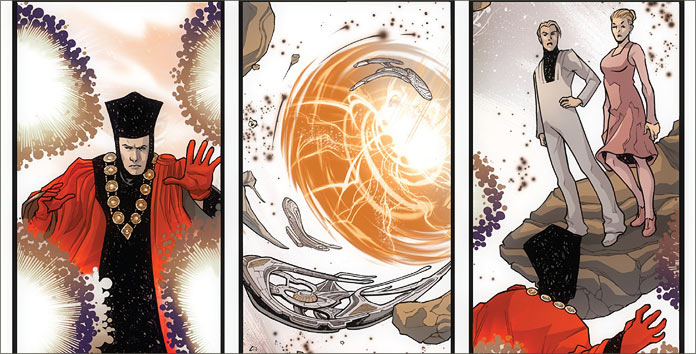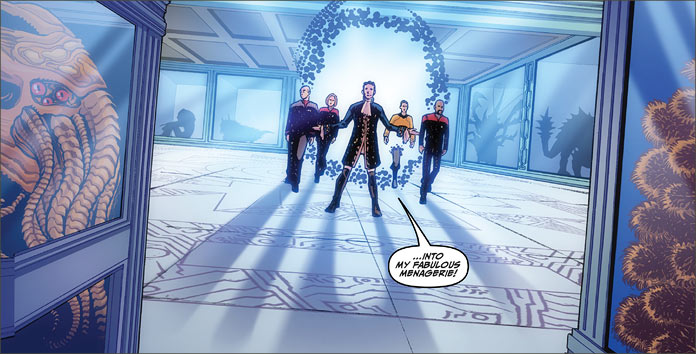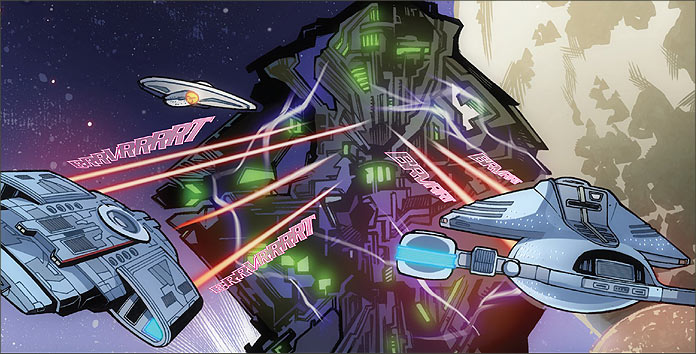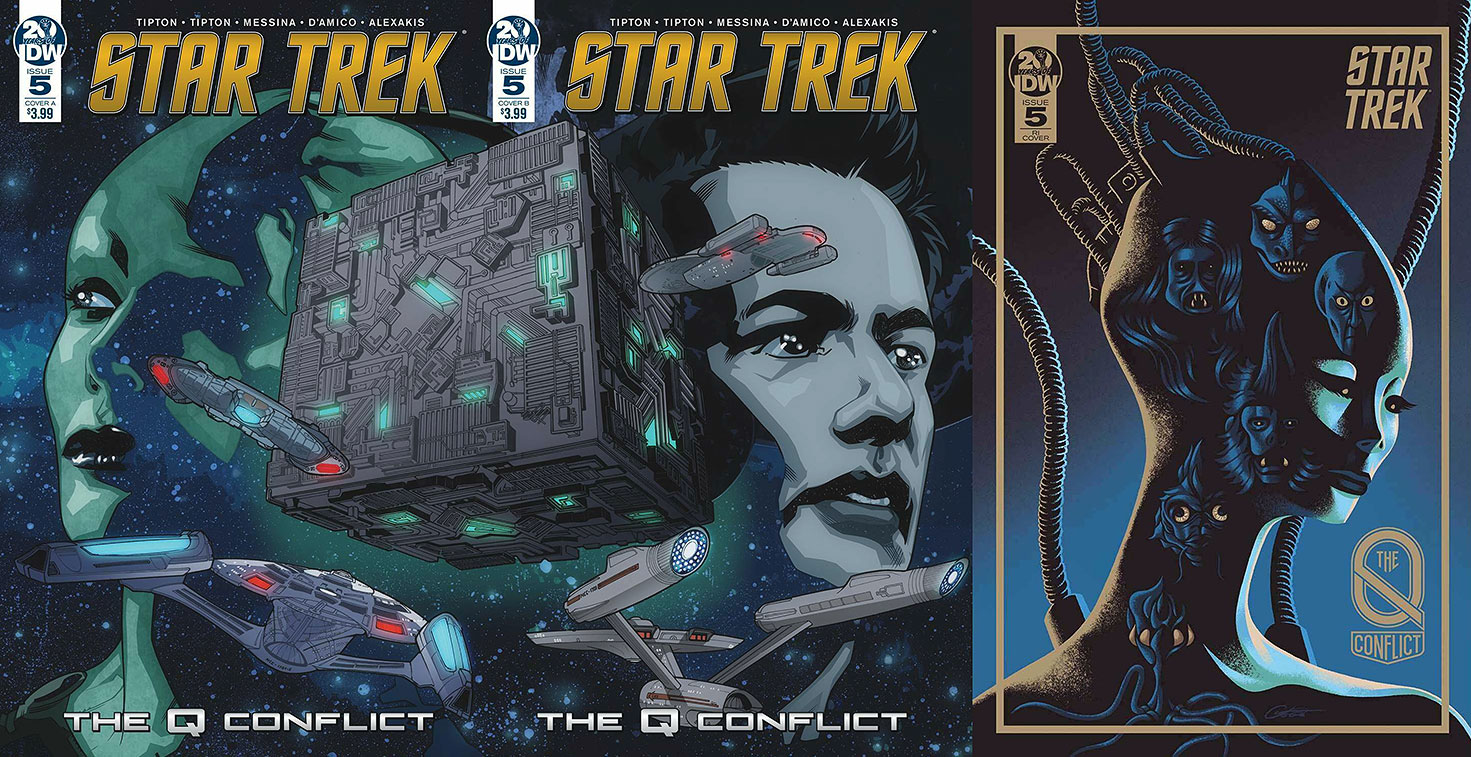How do you overcome the overwhelming sense of futility when dealing with near omnipotent beings? I’ll bet they never covered that one in Starfleet’s training protocols.
Star Trek: The q Conflict #5 is a a story motif that fans can relate to and expect. While an overwhelming sense of frustration might impede the stories in other series, it’s a phenomenon that the different captains and crews of this franchise are used to, and that sets the sets the background for this part of the story.
After all, we are talking about Q – the most pernicious, annoying but popular villain in the Star Trek franchise. Even though one would think a story about confronting an omnipotent being would be present too many obstacles, Star Trek always seemed to do it. Scott and David Tipton have tapped into that motif and, as they are both creators and fans, they are expertly familiar with giving other fans the type of story a fan would expect to read.
The story so far: Q has enraged the Bajoran Prophets by involving them in his contest with the other immortals. The Prophets have demonstrated their discontent by warping time and space to a corporeally unrecognizable extent that even Q cannot contend with. The timely intervention by his fellow Q (Corbin Bernson’s Q from “Deja Q”) and Q-neophyte, Amanda Rodgers (from “True Q”), manage to bring reality back to a level palatable for the Starfleet crews. Q, however, has been placed on notice: no more irresponsible antics or the contest ends, and the war with the other omnipotents resumes, who sense an opportunity to end this charade.
In this issue, Q and Trelane set the next challenge to be the acquisition of a Borg Queen. Quite a daunting task, even for the most advanced starship crew, but given that the selection of crews in this story are from different eras of Star Trek history, the range of available technology puts most of the ships at a disadvantage.

However, the real story is the overall problem: the existence of the contest itself and how the different crews can conspire to extricate themselves from it. That goes back to the tried and true motif of confronting all-powerful, extra-dimensional beings that is a staple feature of a true Star Trek story.
Star Trek comics work because there already is an established fan-base for the franchise and lovers of the comic medium often make up a good portion of Trekkies. Those readers have expectations for a successful story based on established portrayals of characters and any variation that does not have a valid story rationale, will be popularly derided by that fanbase. What’s required for a successful comic is not just a detailed knowledge of Trek trivia but an understanding of the nuances that have made for successful and well-loved stories in different versions of the franchise.
Both David and Scott Tipton have both of those qualities. In extrapolative stories like this, where we have representative characters from four of the versions of this franchise in different situations, the characters have to be accurate. For example, it’s completely within the realm of expectations that Guinan would counsel Captain Picard, especially when it comes to the Q Continuum.

Captain Kirk’s brash and, for lack of a better descriptor, “bulldozer” tactics against the Borg are completely familiar and acceptable, despite their simplistic and brutish nature, they are completely “Kirk”. These behaviours have already been set and it’s the interaction and the speculation as to how these characters would behave in whatever new situation the writers can dream up that provide the entertainment.
That’s the Tiptons’ shared gift. That’s why books like the TNG Mirror Universe, the Trek crossover with Dr. Who or “The Primate Directive” – the shared story set in the “Planet of the Apes” milieu – have also been fan-favorites. Though perhaps not canonically viable, it’s the speculative spirit that matters to long-time fans.
…and in the end, it’s fun. If you can’t have a bit of fun with your fandom, then where’s the joy in it? I mean, I’m really curious to find out how Guinan’s friends involve themselves in ending this conflict, and that’s fun.
Speaking of which, it’s clear that artist David Messina is having fun with this story too. I find his ability to convey part of the story by accurately depicting the same sort of expression one would see in an episode lends itself expertly well in visual storytelling.
Let’s look at the covers to see some more of that expertise.
- Covers ‘A’ and ‘B’ are bookends. Cover ‘A’ is a left-facing perspective of the Borg Queen super-imposed over a Cube, with an attacking Defiant and Enterprise-E in front. Cover ‘B’ is a right-facing perspective with Q taking the place of the Queen over the other half of the Borg Cube and the Enterprise and Voyager in front. Both are by David Messina, and like I said, it’s clear he had a lot of fun with this.
- The retailer-incentive cover is by George Caltsoudas and he doesn’t fail to disappoint with his depiction of the myriad of Trek villains set inside a stylized portrait of the Borg Queen, seemingly in repose. It’s definitely a sophisticated piece of art that will cause a viewer to lose him or herself in its complexity.

To answer the original question posed at the start of this review, overcoming an overwhelming sense of futility involves providing a sense of enjoyment. It’s a sure thing that the Tiptons have accomplished that with this story.
I can’t wait to enjoy the next issue.


